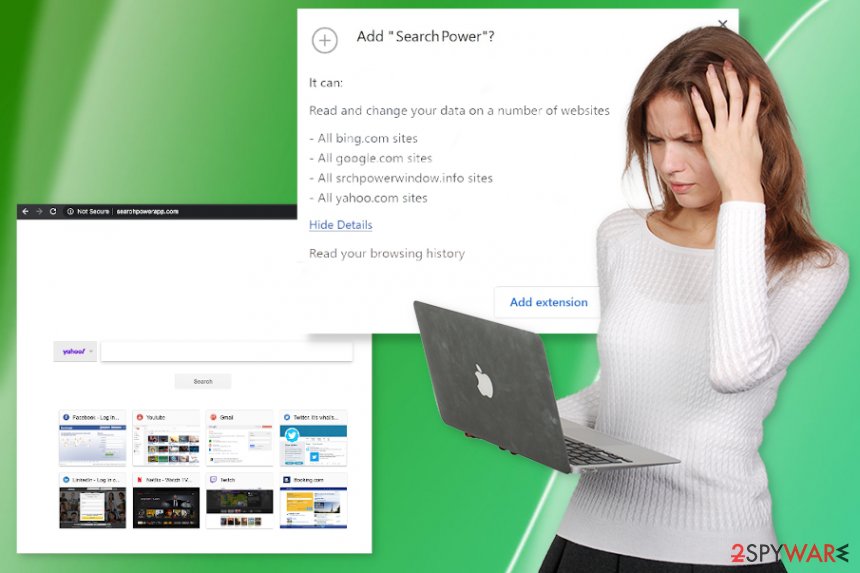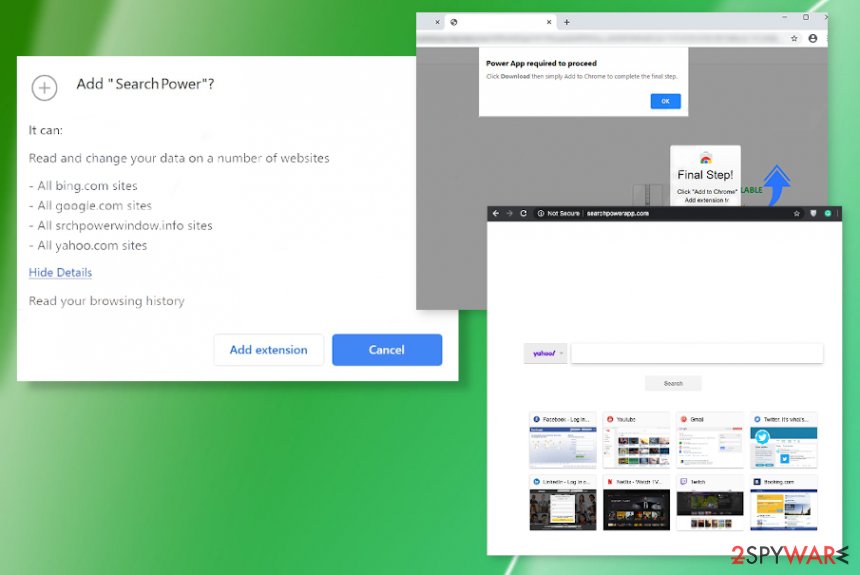Search Power (Removal Instructions) - Free Guide
Search Power Removal Guide
What is Search Power?
Search Power – the browser hijacker that generates advertising revenue from redirects, affected search results

Unfortunately, this intrusive behavior encourages users to call the program a Search Power virus. It redirects to various engines, commercial sites, and most likely going to focus on generating revenue[1] or ad-tracking functions since the PUP is sponsored by other advertisers and various third-party companies. However, these web browsing tool changes are not the only symptoms of the intruder, and once your device is affected by the PUP, you need a thorough cleaning process to tackle the infection fully.
| Name | Search Power |
|---|---|
| Type | Browser hijacker/ Potentially unwanted program |
| Symptoms | The program affects the results of your browsing searches, so the browsing experience is affected, and you more likely to get exposed to sponsored material where views, visits, and clicks get monetized. These manipulated settings also affect the performance significantly |
| Danger | Deceptive sites and commercial content exposes to possibly harmful material and can lead to malicious infections. Also, third-party involvement can lead to privacy or security issues |
| Distribution | Misleading sites, fake updates, and installers, shady installations of freeware when software bundling is used |
| Elimination | SearchPower removal procedure provides the best results for you when the proper anti-malware tools get used. Security tools are needed since PUPs have other applications that may interfere with the persistence while running in the background |
| Repair | To properly clean the system and recover from virus damage, you should run the tool like FortectIntego that can detect affected files, corrupted software and possibly repair those issues automatically |
Search Power is the program that manages to get on the system and affect the speed, performance in a negative way. Even though all the promotional ads for this search engine state about improved search results and boats in the performance and information gathering.
SearchPower adds various tools and files to keep the persistence up, so when you notice the search engine loaded on your screen, you can know that other programs will keep this site on the browser for a longer period. Also, those changes that the hijack makes are not easily changeable. Going through every part of the browser settings section can take time and still give no results.
You need to perform proper Search Power removal by eliminating all PUPs, and do that as soon as you notice any of these:
- changed browser's default search engine;
- altered search queries;
- added browser extensions.
Make sure to clean the machine fully when you encounter Search Power redirects, so you can avoid any infection repetition and ensure that your privacy is no longer at risk. Also, repeat the security scan twice to be completely sure and run FortectIntego for corrupted file recovery and system function repair.

Browser hijackers categorize as potentially unwanted programs because installations happen behind users' back and sometimes stealthily. Search Power is known for triggering downloads and installs on other unwanted applications. Redirect viruses, toolbars, browser extensions, unwanted tabs, and other content can significantly affect the performance of your PC too.
Search Power PUP is promoted with the help of shareware and freeware as an additional part of the downloaded bundle. This method is quite unfair because you can easily miss this sentence that notifies about the installation of this search site. If you want to avoid PUPs, you have to uncheck all the checkboxes that allow developers to install bloatware on your machine. If that is not done during installations, you get this intruder.
This is why we always talk about the persistent and intrusive Search Power hijack and other potentially unwanted programs. Even though all the symptoms are triggered on the browser and involve online behavior, the program itself is running in the background, so all the issues get triggered automatically from the system.
So you need to remove Search Power using proper system tools that can check various parts of the system and indicate threats, associated files, programs and even delete them fully from the system. You do not have the time for this yourself since manually checking every folder, and web browsing tool is a serious job. You can reset browsers fully to default, and save some time, but the machine still remains affected by the PUP. 
The danger of deceptive pages and shady online content
Many cyber intruders that focus on creating browsing issues for the user can infiltrate the machine via deceptive sites and misleading online content. If you constantly visit on pages that offer free downloads, show advertisements, promotional material, or even distributes software, you can get infections like these.
Paying close attention is important because skipping through steps during installation, downloading the program from unreliable sources can automatically trigger the download of the PUP[2] because you are no the one that controls those processes. Especially when you choose Recommended or Quick installation options. Experts[3] always talk about the importance of the Advanced freeware installations.
If you want to avoid these unwanted programs and shady infections, you need to go for official sites, providers, or developers and get programs from there instead of pop-up ads and promotional domains. Another tip is to choose Advanced or Custom options during every installation process. This way you can see all the included applications and block any suspicious ones by deselecting them from the list.
Get rid of the shady Search Power PUP and forget about useless redirects and browser-based applications
To remove Search Power safely and forget about the unwanted content that this program shows to you, you should use tools designed for cleaning the system thoroughly like security utilities and AV engines. Any anti-malware that you trust can be employed for the job. Uninstalling the program is not enough since there might be additional tools or harmful programs added to the system.
So Search Power removal can be time-consuming when you need to find all threats related to the hijacker, so follow our guidelines down below for browser resetting, and then scan your system fully with tools we suggest. Make sure that you eliminate all possible threats, additional programs, files that trigger background processes form the system, and change browser setting back to default.
This way, you will get a chance to ensure that there are no browser hijacker components left on your system. Also, remember to clear the damage that the Search Power virus may cause behind your back. You can do that with system optimizers and tools listed as PC repair.
You may remove virus damage with a help of FortectIntego. SpyHunter 5Combo Cleaner and Malwarebytes are recommended to detect potentially unwanted programs and viruses with all their files and registry entries that are related to them.
Getting rid of Search Power. Follow these steps
Uninstall from Windows
Instructions for Windows 10/8 machines:
- Enter Control Panel into Windows search box and hit Enter or click on the search result.
- Under Programs, select Uninstall a program.

- From the list, find the entry of the suspicious program.
- Right-click on the application and select Uninstall.
- If User Account Control shows up, click Yes.
- Wait till uninstallation process is complete and click OK.

If you are Windows 7/XP user, proceed with the following instructions:
- Click on Windows Start > Control Panel located on the right pane (if you are Windows XP user, click on Add/Remove Programs).
- In Control Panel, select Programs > Uninstall a program.

- Pick the unwanted application by clicking on it once.
- At the top, click Uninstall/Change.
- In the confirmation prompt, pick Yes.
- Click OK once the removal process is finished.
Delete from macOS
Remove items from Applications folder:
- From the menu bar, select Go > Applications.
- In the Applications folder, look for all related entries.
- Click on the app and drag it to Trash (or right-click and pick Move to Trash)

To fully remove an unwanted app, you need to access Application Support, LaunchAgents, and LaunchDaemons folders and delete relevant files:
- Select Go > Go to Folder.
- Enter /Library/Application Support and click Go or press Enter.
- In the Application Support folder, look for any dubious entries and then delete them.
- Now enter /Library/LaunchAgents and /Library/LaunchDaemons folders the same way and terminate all the related .plist files.

Remove from Microsoft Edge
Delete unwanted extensions from MS Edge:
- Select Menu (three horizontal dots at the top-right of the browser window) and pick Extensions.
- From the list, pick the extension and click on the Gear icon.
- Click on Uninstall at the bottom.

Clear cookies and other browser data:
- Click on the Menu (three horizontal dots at the top-right of the browser window) and select Privacy & security.
- Under Clear browsing data, pick Choose what to clear.
- Select everything (apart from passwords, although you might want to include Media licenses as well, if applicable) and click on Clear.

Restore new tab and homepage settings:
- Click the menu icon and choose Settings.
- Then find On startup section.
- Click Disable if you found any suspicious domain.
Reset MS Edge if the above steps did not work:
- Press on Ctrl + Shift + Esc to open Task Manager.
- Click on More details arrow at the bottom of the window.
- Select Details tab.
- Now scroll down and locate every entry with Microsoft Edge name in it. Right-click on each of them and select End Task to stop MS Edge from running.

If this solution failed to help you, you need to use an advanced Edge reset method. Note that you need to backup your data before proceeding.
- Find the following folder on your computer: C:\\Users\\%username%\\AppData\\Local\\Packages\\Microsoft.MicrosoftEdge_8wekyb3d8bbwe.
- Press Ctrl + A on your keyboard to select all folders.
- Right-click on them and pick Delete

- Now right-click on the Start button and pick Windows PowerShell (Admin).
- When the new window opens, copy and paste the following command, and then press Enter:
Get-AppXPackage -AllUsers -Name Microsoft.MicrosoftEdge | Foreach {Add-AppxPackage -DisableDevelopmentMode -Register “$($_.InstallLocation)\\AppXManifest.xml” -Verbose

Instructions for Chromium-based Edge
Delete extensions from MS Edge (Chromium):
- Open Edge and click select Settings > Extensions.
- Delete unwanted extensions by clicking Remove.

Clear cache and site data:
- Click on Menu and go to Settings.
- Select Privacy, search and services.
- Under Clear browsing data, pick Choose what to clear.
- Under Time range, pick All time.
- Select Clear now.

Reset Chromium-based MS Edge:
- Click on Menu and select Settings.
- On the left side, pick Reset settings.
- Select Restore settings to their default values.
- Confirm with Reset.

Remove from Mozilla Firefox (FF)
Remove dangerous extensions:
- Open Mozilla Firefox browser and click on the Menu (three horizontal lines at the top-right of the window).
- Select Add-ons.
- In here, select unwanted plugin and click Remove.

Reset the homepage:
- Click three horizontal lines at the top right corner to open the menu.
- Choose Options.
- Under Home options, enter your preferred site that will open every time you newly open the Mozilla Firefox.
Clear cookies and site data:
- Click Menu and pick Settings.
- Go to Privacy & Security section.
- Scroll down to locate Cookies and Site Data.
- Click on Clear Data…
- Select Cookies and Site Data, as well as Cached Web Content and press Clear.

Reset Mozilla Firefox
If clearing the browser as explained above did not help, reset Mozilla Firefox:
- Open Mozilla Firefox browser and click the Menu.
- Go to Help and then choose Troubleshooting Information.

- Under Give Firefox a tune up section, click on Refresh Firefox…
- Once the pop-up shows up, confirm the action by pressing on Refresh Firefox.

Remove from Google Chrome
Delete malicious extensions from Google Chrome:
- Open Google Chrome, click on the Menu (three vertical dots at the top-right corner) and select More tools > Extensions.
- In the newly opened window, you will see all the installed extensions. Uninstall all the suspicious plugins that might be related to the unwanted program by clicking Remove.

Clear cache and web data from Chrome:
- Click on Menu and pick Settings.
- Under Privacy and security, select Clear browsing data.
- Select Browsing history, Cookies and other site data, as well as Cached images and files.
- Click Clear data.

Change your homepage:
- Click menu and choose Settings.
- Look for a suspicious site in the On startup section.
- Click on Open a specific or set of pages and click on three dots to find the Remove option.
Reset Google Chrome:
If the previous methods did not help you, reset Google Chrome to eliminate all the unwanted components:
- Click on Menu and select Settings.
- In the Settings, scroll down and click Advanced.
- Scroll down and locate Reset and clean up section.
- Now click Restore settings to their original defaults.
- Confirm with Reset settings.

Delete from Safari
Remove unwanted extensions from Safari:
- Click Safari > Preferences…
- In the new window, pick Extensions.
- Select the unwanted extension and select Uninstall.

Clear cookies and other website data from Safari:
- Click Safari > Clear History…
- From the drop-down menu under Clear, pick all history.
- Confirm with Clear History.

Reset Safari if the above-mentioned steps did not help you:
- Click Safari > Preferences…
- Go to Advanced tab.
- Tick the Show Develop menu in menu bar.
- From the menu bar, click Develop, and then select Empty Caches.

After uninstalling this potentially unwanted program (PUP) and fixing each of your web browsers, we recommend you to scan your PC system with a reputable anti-spyware. This will help you to get rid of Search Power registry traces and will also identify related parasites or possible malware infections on your computer. For that you can use our top-rated malware remover: FortectIntego, SpyHunter 5Combo Cleaner or Malwarebytes.
How to prevent from getting browser hijacker
Access your website securely from any location
When you work on the domain, site, blog, or different project that requires constant management, content creation, or coding, you may need to connect to the server and content management service more often. The best solution for creating a tighter network could be a dedicated/fixed IP address.
If you make your IP address static and set to your device, you can connect to the CMS from any location and do not create any additional issues for the server or network manager that needs to monitor connections and activities. VPN software providers like Private Internet Access can help you with such settings and offer the option to control the online reputation and manage projects easily from any part of the world.
Recover files after data-affecting malware attacks
While much of the data can be accidentally deleted due to various reasons, malware is one of the main culprits that can cause loss of pictures, documents, videos, and other important files. More serious malware infections lead to significant data loss when your documents, system files, and images get encrypted. In particular, ransomware is is a type of malware that focuses on such functions, so your files become useless without an ability to access them.
Even though there is little to no possibility to recover after file-locking threats, some applications have features for data recovery in the system. In some cases, Data Recovery Pro can also help to recover at least some portion of your data after data-locking virus infection or general cyber infection.























